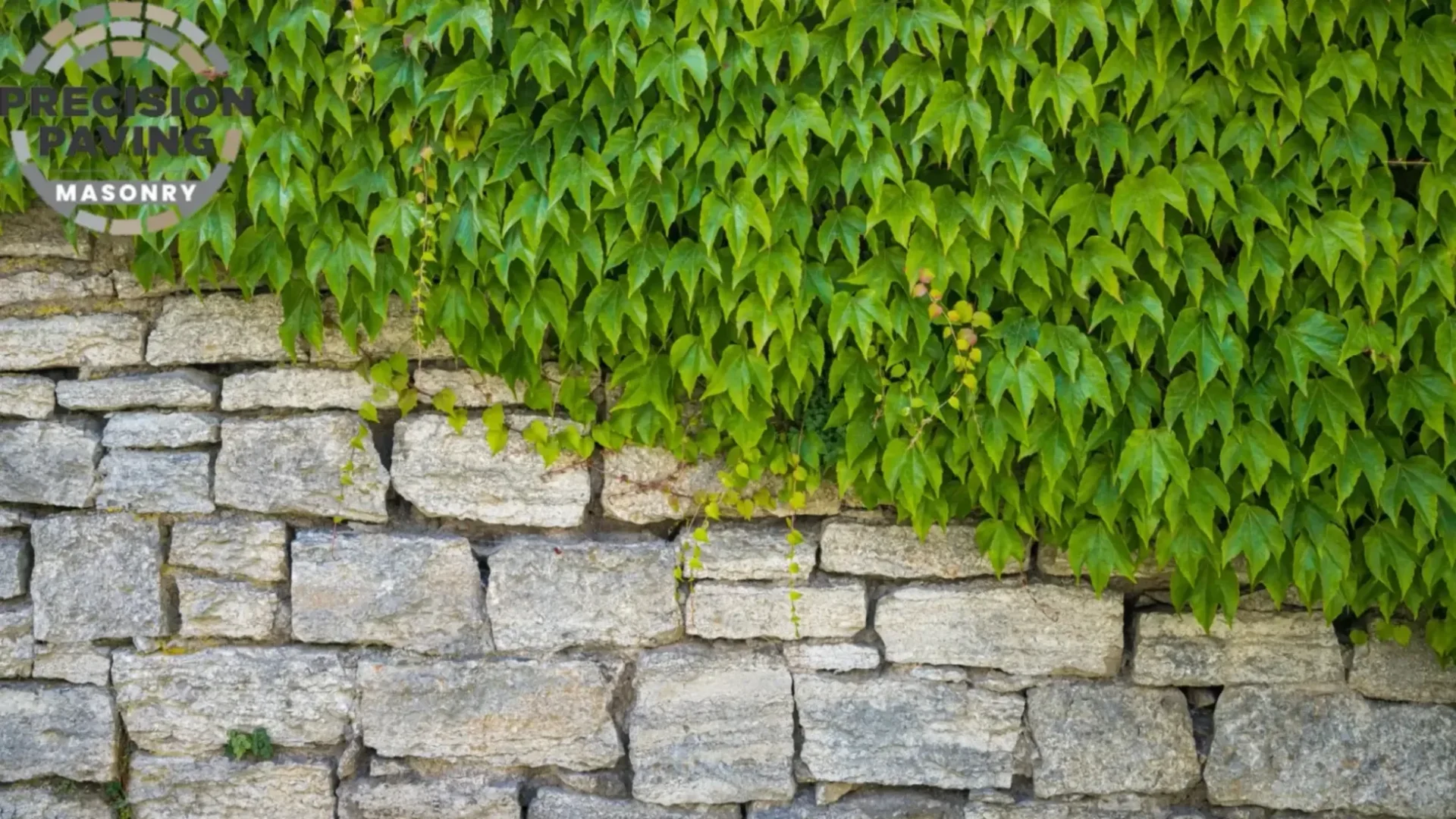A retaining wall is a structure, built to stop or hold back soil behind it, supporting and preventing erosion and landslides. These walls are particularly important in landscaping and construction, especially where there are significant changes in height above sea level. Retaining walls have functional uses as well as the ability to enhance the beauty of a property by creating flat areas for gardens, patios, and driveways, among other land features. But what exactly what are retaining walls, and how can they benefit your property?
In this article, we will look at what retaining walls are, such as the types available when buying them, their advantages, and a host of factors that need to be considered before installing one. We shall also delve into the design and planning stages involved when coming up with this kind of a along with materials used and steps required during its erection.
In addition, there are maintenance and repair tips that will be given out, along with cost considerations that can help you draw conclusions on how much should be incurred while constructing such types of walls; We shall also address some common concerns about these kinds of structures. By the end of this blog, you will have learned enough that will enable you to know whether or not it would be good to go ahead and install one in your compound as well as take care of it afterward.
What Are Retaining Walls Block and the Different Types Available?
Here, we will cover mainly what are retaining walls. And what comes in different types so that each meets specific structural criteria and aesthetic needs. Understanding these differences can assist you in picking an ideal option for your project. The following are some of the more commonly encountered forms and key attributes.
1. Gravity Retaining Walls Block
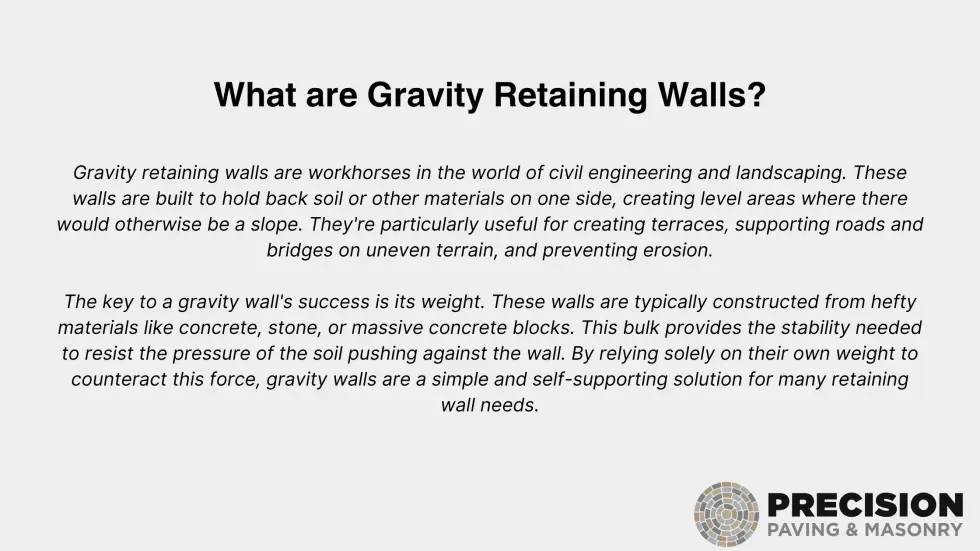
Gravity Retaining Walls Block
- Relies on its weight for soil pressure resistance.
- Made from such heavy materials as concrete, stones, or masonry.
- It is a simple design that uses the mass of the wall to ensure stability.
- More suitable for shorter heights.
- Commonly found in residential landscapes.
2. Cantilever Retaining Walls Block
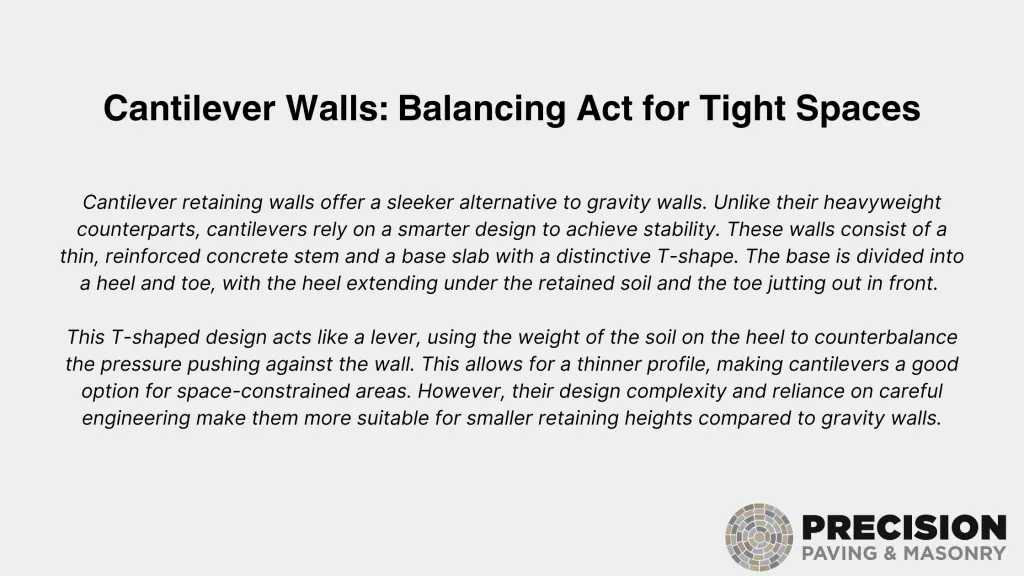
Cantilever Retaining Walls Block
- This is designed with a reinforced concrete stem and a base slab.
- The base slab comprises the heel, which extends backward into the soil, and the toe which extends forward.
- The wall is stabilized by the weight of backfill soil on the heel
- Preferred for tall structures
- Frequently seen in commercial and civil engineering projects
3. Sheet Piling Retaining Walls Block
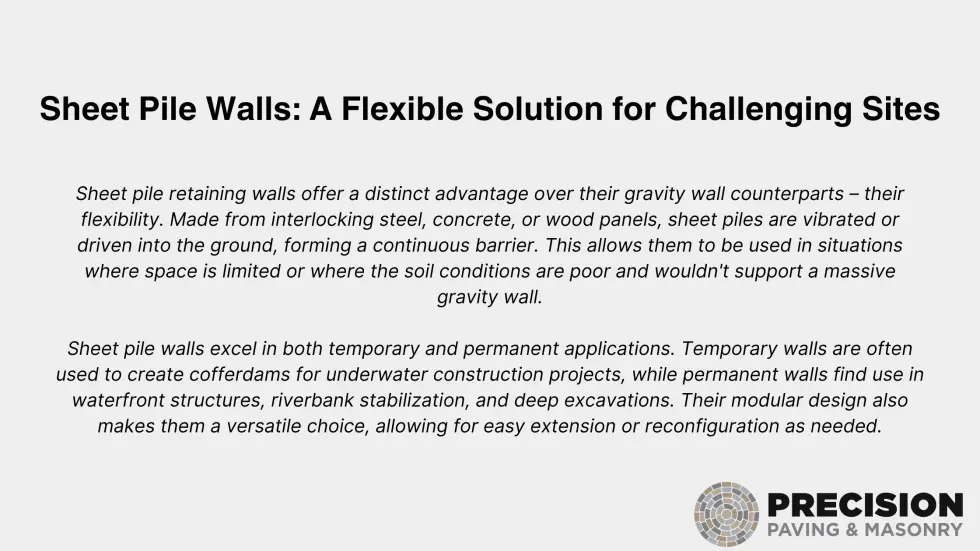
Sheet Piling Retaining Walls Block
- These are made up of interlocking vertical sheets (steel, vinyl, or wood).
- Sheets are driven deeply into the ground to provide support beneath them.
- It is useful when there is soft soil or little space available
- Often used in temporary constructions, waterfront properties, and urban settings
- Serves as both a retaining soil and a control for groundwater flow
4. Anchored Retaining Walls Block
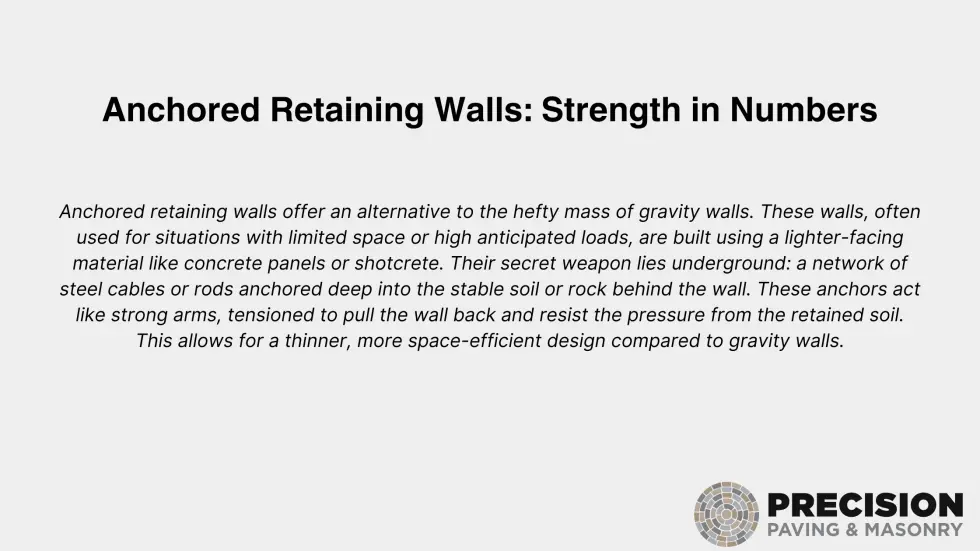
Anchored Retaining Walls Block
- Arguably, more often than not, it relies on anchors or tiebacks driven into the ground to improve strength (reinforced).
- Anchors are connected using cables or rods.
- This permits the construction of thinner walls with considerable strength and stability levels.
- Recommended for carrying heavy loads or where there is inadequate space available (space-restricted).
- They are employed in deep excavation support and where existing structures limit wall area.
5. Hybrid-Retaining Walls Block
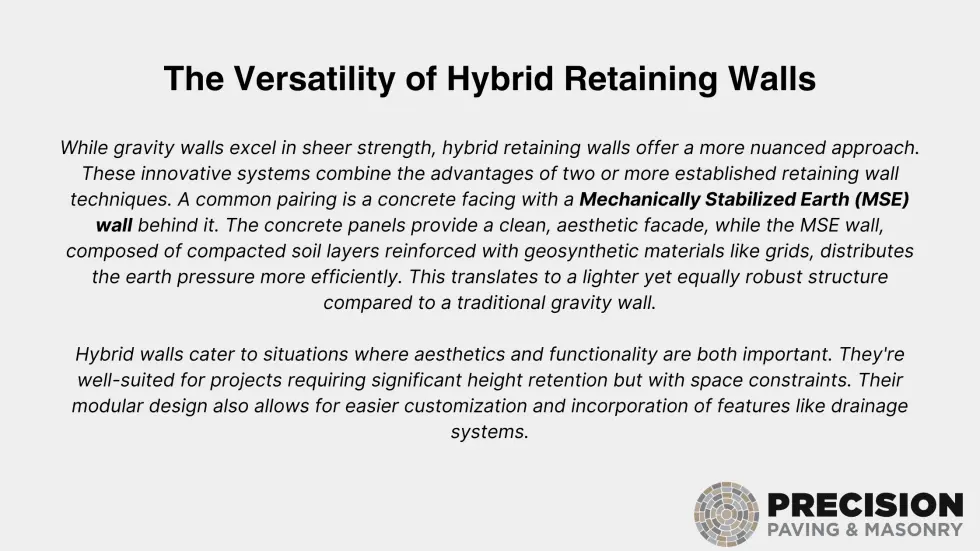
Hybrid-Retaining Walls Block
- Several retaining wall types are merged.
- They are constructed to meet the site’s conditions and design requirements.
- Examples include merging a gravity wall mass with anchors or interlocking sheet piles.
- Appropriate for difficult sites and complex projects.
- They provide choices without compromising on the unique structural and aesthetic needs of the project.
6. Retaining Walls with Concrete Blocks
Retaining Walls with Concrete Blocks are a popular choice for both residential and commercial landscaping projects. These walls are designed to retain soil or other materials and prevent erosion or collapse in areas with sloping or uneven terrain. Concrete block retaining walls are particularly favored due to their strength, durability, and versatility.
Key Features of Retaining Walls with Concrete Blocks:
- Strong & Durable: Concrete blocks are tough and weather-resistant.
- Versatile: Available in different sizes and styles for creative designs.
- Cost-Effective: Low maintenance over time, saving money.
- Easy to Install: Can be built without mortar, making DIY projects simpler.
- Weather-Resistant: Handles rain, snow, and drainage well, preventing erosion.
- Supportive: Ideal for areas with steep slopes or high pressure.
Different types of retaining walls have specific strengths that make them ideal for different applications, so one can always choose what is best for their particular project needs.
Top Benefits of Installing Retaining Walls Block on Your Property
Let’s see what are retaining walls how do they benefit us! Retaining walls has many benefits that go beyond their main function of holding back soil. These structures serve important roles such as erosion control, flood prevention, and increasing property value in home landscaping and large-scale construction projects.
1. Soil Erosion Control
Retaining walls effectively prevent soil erosion by holding it back, especially in slanting lands. This keeps the land healthy and prevents damage to structures around it.
2. Flood Protection
Retaining walls helps manage water run-, thus reducing chances of flooding. Properly designed walls have drainage systems that direct the rainwater away from areas where this may cause harm through accumulation.
3. Flood Prevention
By controlling the outflow of water, retaining walls reduce flood risks. Properly constructed walls are those that have drainage systems that carry away water from areas prone to flooding and thus build up and result damage.
4. Increasing property values
Constructing a retaining wall increases the value of your home when it is finally sold. Landscape architects add more color to land that, when seen from a distance, turns on buyers for purchases, apart from increasing stability and making the ground firm enough.
5. Improving Aesthetic Value
Retaining walls make outdoor spaces more beautiful. These can be designed by the architecture of your house to make terraces and flower beds, among other things, allowing one to personalize them.
6. Land use Maximization
On sloping grounds, retaining walls create flat grounds that maximize space utilization. This provides additional functional space for gardens, patios, driveways, or recreational areas to allow efficient use of land.
Many advantages come along with building retaining walls, including erosion control and flood prevention, among others. They also provide extra usable making improvements, both visual and functional.
Key Factors to Consider for Retaining Walls Block Installation
There are some important factors you must address before knowing what are retaining walls if you are going to work properly, last long enough, and meet all requirements necessary for its establishment.
1. Soil Type and Condition
Assess the soil’s bearing capacity and drainage properties to determine the appropriate design and materials for your retaining wall.
2. Slope and Terrain
Consider the slope and terrain of the site, as steeper slopes may require more robust retaining systems for stability.
3. Local Building Codes and Regulations
Check local building codes and regulations for design standards, height restrictions, and necessary permits to ensure compliance and avoid legal issues.
4. Drainage and Water Management
Incorporate proper drainage solutions, such as weep holes and drainage pipes, to prevent water buildup behind the wall and reduce pressure.
5. Budget and Cost Considerations
Plan a realistic budget, considering both initial construction costs and long-term maintenance expenses, to avoid financial strain.
6. Retaining Wall Height
The height of the wall will influence the design and materials used, as taller walls require stronger foundations and structural support.
By taking these factors into account, you can design and build an effective, durable, and compliant retaining wall that enhances your property.
Designing and Planning Retaining Walls Block the Right Way
- Assessing Site Requirements: Evaluate soil conditions, slope, and terrain.
- Choosing the Right Type: Select the appropriate retaining wall type (gravity, cantilever, sheet piling, anchored, or hybrid).
- Structural Engineering and Load Calculations: Ensure the wall can withstand soil pressure and other forces.
- Add Weep Holes and Drainage Pipes for Water Management
- Aesthetic vs. Functional Design Elements: Improve visual appeal and usability to suit the site.
Best Materials for Building Retaining Walls Block
To make a retaining wall attractive and long-lasting, it is important to select the right construction material. Below are some common options:
- Concrete blocks: Lasting, flexible, easy to put up.
- Natural stone: Timeless in appearance, fits well with the environment.
- Timber: It has a natural and rustic charm, but needs regular maintenance.
- Brick: It has an ageless look that is resistant if installed correctly.
- Gabion: Modern look; good drainage and erosion protection
Each of these materials has distinct advantages that will fit various tastes in beauty and other project requirements of different projects.
Step-by-Step Retaining Walls Block Construction Guide
Building a retaining wall follows systematic procedures aimed at achieving durability and functionality. Initially, clean away any debris from the area and level it as necessary through excavation. After this, establish a strong foundation, whether through concrete footing or compacted gravel to support your design.
Constructing a Retaining Wall Steps:
- Site Preparation and Excavation: Clear & level where the wall would be built.
- Laying the Foundation: Firm base; either concrete or compacted gravel.
- Implementing Drainage Solutions: For instance, place weep holes or drainage pipes behind the wall.
- Backfilling and Compacting Soil: This means that fill soil behind the wall by mechanically compacting it to have a solid mass.
- Final Touches and Landscaping: For example, add capstones and blend your landscaping design with this wall.
How to Maintain and Repair Retaining Walls Block Effectively
To keep your retaining wall in top condition, regular inspections and maintenance are essential. Learn more about how to repair a retaining wall to understand the best practices and steps involved in maintaining its integrity.
- Inspect Regularly: Conduct regular checks for any damage or erosion of the structure.
- Maintain Drainage: Clear all drainage systems that may have been blocked by debris.
- Repair Promptly: Crack repairs should be done immediately before they become extensive thereby making them difficult to repair later on.
- Strengthen as Needed: In case of any damage, fix it as soon as possible so that your walls can be stronger than they were before.
- Prevent Issues: Employ sealers, customize slopes, manage grading schedule and vegetation control, etc. This will help prevent future defects from occurring in your retaining walls.
- Building the Wall Structure: Construct the wall using chosen materials, ensuring proper alignment and levelness.
- Implementing Drainage Solutions: Install drainage features like weep holes or drainage pipes behind the wall.
- Backfilling and Compacting Soil: Fill behind the wall with soil or gravel, compacting it for stability.
- Final Touches and Landscaping: Add finishing touches like capstones and integrate the wall into your landscaping design.
FAQs
Q. What Do Retaining Walls Do?
A: Retaining walls hold back the soil. This often applies to places with small hills, where these barriers prevent the earth from sliding ahead into an avalanche.
Q. What Is Regarded as a Retaining Wall?
A: Retaining Wall, It refers to any wall that is specifically designed to withstand horizontal earth or fluid pressures and includes any surcharge following accepted engineering practice. This definition also applies to free-standing pool walls.
Q. What Makes a Retaining Wall Different from the Others?
A: A retaining wall is a solid structure built to hold back landslides, soil erosion, or hillocks. Unlike indoor walls, pressure coming from retaining walls is not vertically but horizontally facing. A strong construction must be used because of the heaviness of the earth against it.
Q. What Differentiates a Boundary Wall from a Retaining One?
A: Retaining walls are separate from freestanding walls. These do not prevent the topsoil from sliding away. They are an aesthetic feature in hardscape design, however, they have their functionalities too. With the addition of this kind of wall, patios can be converted into external living spaces.
Q: How to Construct a Retaining Wall Using Concrete Blocks?
A: Start by digging a trench for the base, lay a gravel foundation, place the first row of blocks, and stack additional rows while ensuring they’re level. Use adhesive or pins between layers and backfill with gravel as you go.
Q: How Many Retaining Wall Blocks Do I Need?
A: Measure the length, height, and depth of the wall, then divide the wall’s total volume by the size of one block to get an estimate. Many online calculators may also help.
Q: Can You Build a Retaining Wall with Cinder Blocks?
A: Yes, but cinder blocks should be reinforced with steel bars and concrete fill for added strength and durability.
Q: How Long Do Concrete Retaining Walls Last?
A: Concrete retaining walls can last 50 to 100 years with proper construction and maintenance.
Q: Which Retaining Wall Is Best?
A: The best wall depends on your needs. Concrete blocks provide strength and versatility, while natural stone enhances the visual appeal with its timeless beauty. Consult a professional for your specific project.
Q: When Are Retaining Walls Required?
A: Retaining walls are required when there’s a need to prevent soil erosion, manage water runoff, or level sloped areas for landscaping or construction.
Q: Are Retaining Wall Blocks Fireproof?
A: Yes, most concrete retaining wall blocks are fire-resistant, making them suitable for areas with fire hazards.
Conclusion
Both in private homes and commercial landscaping and construction sites, retaining walls are necessary structures. They check soil erosion, control water movement, and add to the beauty of a premise. Whether you choose gravity, cantilever, sheet piling, anchored or hybrid being aware of the advantages and the steps in erection and management for these walls is important to ensure their durability and efficiency.
By considering factors such as type of soil, slope angle, local codes on buildings, drainage system, and budget among others you can come up with a design that will meet your needs while adding value to your property. Choosing materials well and sticking to best practices during construction will give you a long-lasting wall that also looks nice.
Your retaining wall should be maintained regularly so as not only to keep it in good condition but also to ensure that it serves its purpose of supporting your land as an added investment. To get professional services on installing a retaining wall contact us today for more information.
